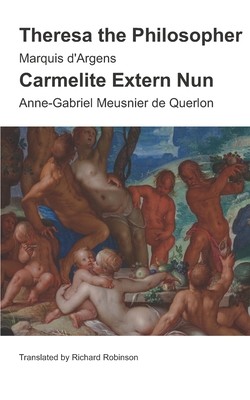
- We will send in 10–14 business days.
- Author: Anne-Gabriel Meusnier De Querlon
- Publisher: Sunny Lou Publishing
- Year: 2021
- Pages: 198
- ISBN-10: 1955392021
- ISBN-13: 9781955392020
- Format: 12.7 x 20.3 x 1.1 cm, minkšti viršeliai
- Language: English
- SAVE -10% with code: EXTRA
Theresa the Philosopher & The Carmelite Extern Nun (e-book) (used book) | bookbook.eu
Reviews
Description
Theresa the Philosopher, by the marquis dʼArgens (purportedly), was published in 1748, over 270 years ago - before the modern era, before the Napoleonic phenomenon, before the Directorate, before the French Revolution. It is a happy tale with a happy ending, with not a little bit of hanky-panky slapped in between. Compared to Samuel Richardson's Pamela, published in 1740, which was the first modern (albeit English) novel, whose characters are more than two-dimensional and whose story depends more on what happens inside the mind of the characters than, say, where a boat might go (like Robinson Crusoe for example) - Theresa the Philosopher is scandalous. Compared to the marquis de Sade's Justine, which was published in 1791, it may seem tame. According to the marquis de Sade, Theresa the Philosopher "achieved happy results from the combining of lust and impiety... [it] gave us an idea of what an immoral book could be."The Carmelite Extern Nun, written by Anne-Gabriel Meusnier de Querlon, and published one year earlier, in 1747, is another whopper. It is the "Amorous True Story [of Saint Nitouche], the Carmelite Extern Nun, Written by Herself, and Addressed to her Mother Superior." It is anticlericalism, antiestablishmentarianism, and eroticism - the three main pillars or themes, sometimes even agendas, of the 18th century libertine novel - all in one short, but fast-paced, scandalous sack.EXTRA 10 % discount with code: EXTRA
The promotion ends in 21d.23:24:06
The discount code is valid when purchasing from 10 €. Discounts do not stack.
- Author: Anne-Gabriel Meusnier De Querlon
- Publisher: Sunny Lou Publishing
- Year: 2021
- Pages: 198
- ISBN-10: 1955392021
- ISBN-13: 9781955392020
- Format: 12.7 x 20.3 x 1.1 cm, minkšti viršeliai
- Language: English English


Reviews